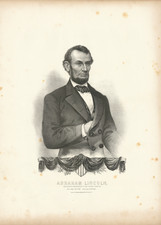Troop of Soldiers and a Yankton Sioux by Bodmer
A beautiful hand-colored engraving of two Native American men by Karl Bodmer, originally issued as Tab 12. in the atlas to Prince Maximilian of Wied's famous travel account of the Western Plains, Travels in the Interior of North America (1839-43).
Karl Bodmer was engaged by Prince Maximilian zu Wied-Neuwied to provide a record of his travels in North America, with his final destination being time spent among the Plains Indians. Along with Davide Dreidoppel (Prince Maximilian's servant and hunting companion), the the trio travelled 1832 to 1834. They arrived in Boston in July 1832, traveled on to Philadelphia, where they stayed with Napoleon Bonaparte's elder brother Joseph. From here they headed west across Pennsylvania across the Alleghenies to Pittsburgh and the Ohio country, visiting all the important German settlements en route. The most important stop on their route west was at the utopian colony of New Harmony in Indiana. The Prince spent five months there in the company of some of the country's leading scientific men, and studying all the relevant literature on backcountry America. The trip into the Plains region commenced in March 1833.
Maximilian and Bodmer met Noapéh (Troop of Soldiers) at Fort Union (in present-day North Dakota) in June 1833. The prince was fascinated by Noapéh's antelope horn headdress, even going so far to acquire a similar one for his personal collection.
Maximilian’s monumental account first appeared in German (1839-41), followed by a French translation in 1840-43 and an English edition in 1843. The Paris-issued pictorial atlas contained eighty-one aquatint plates (48 "imperial" folios and 33 smaller "vignette" plates often called quarto in size), engraved and etched on metal sheets, after paintings by Karl Bodmer, and which accompanied all three editions. The plates are outstanding authentic depictions of the western plains and Native Americans by a highly skilled European artist. Bodmer avoided romanticizing his subjects, and attempted to record the people and places he encountered as true to life as possible.
The present print is from the 1922 Leipzig edition by Schmidt & Guenther, which was issued on thicker vellum paper than the 19th century originals.










![(Mexican-Aztec Paintings) [Chapultepec and Coyotepec] Mexican Painting. 3738. Codex Vaticanus, page 130, Aglio 2 Vol.](https://storage.googleapis.com/raremaps/img/small/102306.jpg)
![[Original photograph:] Native American group image, possibly in Indian Territory, with White Settlers](https://storage.googleapis.com/raremaps/img/small/82871.jpg)
![(Cleveland Beer Drinkers) [Photograph of Zwiebel Brigade Drinking Beer in Cleveland]](https://storage.googleapis.com/raremaps/img/small/96294.jpg)

![(Mexican-Aztec Painting) [Watercolor of four Aztec deities from the Codex Telleriano Remensis and Codex Vaticanus]](https://storage.googleapis.com/raremaps/img/small/103011.jpg)